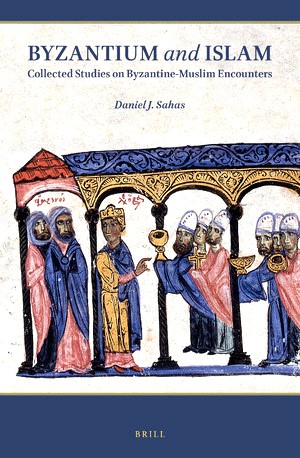Daniel J. Sahas: Byzantium and Islam
Collected Studies on Byzantine-Muslim Encounters
Leiden: Brill 2021, 630 pp., index
E-Book (PDF) – ISBN 978-90-04-47047-7
Festeinband – ISBN: 978-90-04-47044-6
Mehr zum Autor :
Daniel J. Sahas, Professor em. für Patristik, University of Waterloo, Ontario, Canada
Editor’s Information
Arabs and the Middle East were among the first to embrace Christianity, leaving their print on its culture. Thus Byzantium, by geography and culture, encountered Islam at its birth. No wonder that many saw and treated Islam as a contemporary Christian “heresy” – whatever the word may connote. Radical events fill the history of Byzantium (330-1453) encountering the world of Islam: conquests, wars, cultural and diplomatic relations, manifestations of mutual admiration – and exclusion! Their story makes for a fascinating branch of either Byzantine or Islamic studies; the literature about each other forming a distinguished section in either field. This collection of studies is a sample of Byzantine perspectives of Islam offering, hopefully, expressions and solutions rather than creating impressions or illusions.
Deutsche Erläuterung
Die arabische Halbinsel und die Länder des Nahen und Mittleren Ostens – aber auch Nord- und Ostafrika – gehörten zu den ersten, in denen das Christentum heimisch wurde und die Kultur der Region prägte. So traf das Byzantinische Reich bei der Entstehung des Islam geografisch und kulturell mit dem Islam zusammen. Kein Wunder, dass viele den Islam als eine zeitgenössische christliche „Häresie“ betrachteten und entsprechend behandelten – was auch immer das Wort „Häresie“ bedeuten mag. Die Geschichte der Begegnung von Byzanz (330 –1453) mit der islamischen Welt ist voller einschneidender Ereignisse: Eroberungen, Kriege, kulturelle und diplomatische Beziehungen, Manifestationen gegenseitiger Bewunderung – aber auch Ausgrenzungen!
Diese Geschichte im Kontext von Byzanz und Islam stellt einen faszinierenden Zweig der Byzantinistik bzw. der Islamwissenschaft dar; die Literatur über die jeweils andere Seite bildet einen herausragenden Abschnitt in beiden Bereichen.
Die hier vorgelegte Sammlung von Studien ist ein Beispiel für die byzantinische Sichtweise des Islam, die hoffentlich eher adäquate Ausdrucksformen und Lösungen bietet, als bloße Eindrücke oder gar Illusionen zu schaffen.
Mehr zum östlichen Christentum
Christentum weltweit – von den Anfängen bis heute
Arabien in der Spätantike und die Anfänge des Islam:
Inhaltsverzeichnis / Contents
Front Matter
Preliminary Material — Copyright page — Preface
Previously Published in Part 1:
Part 1 Mental and Theological Predispositions for a Relationship, or Conflict
Chapter 1
The Notion of “Religion” with Reference
to Islam in the Byzantine Anti-islamic Literature
Seiten: 3–12
Chapter 2
Βυζάντιο, Ισλάμ και αντι-Ισλαμική γραμματεία (7ος–15οςαι.)
Seiten: 13–48
Chapter 3
The Christological Morphology of the Doctrine of the Qurʾān
Seiten: 49–69
Chapter 4
The Formation of Later Islamic Doctrines as a Response
to Byzantine Polemics: The Miracles of Muhammad
Seiten: 70–84
Chapter 5
Monastic Ethos and Spirituality and the Origins of Islam
Seiten: 85–96
Chapter 6
The Art and Non-Art of Byzantine Polemics: Patterns of Refutation
in Byzantine Anti-Islamic Literature
Seiten: 97–115
Chapter 7
The “Oriental” Character of the Byzantine-Islamic Relations:
One Essence – Various Expressions
Seiten: 116–137
Part 2 Historical Preambles under the Sting of the Arab Conquests
Chapter 8
The Face to Face Encounter between Patriarch
Sophronius of Jerusalem and the Caliph ʿ
Umar Ibn Al-Khattāb: Friends or Foes?
Seiten: 141–151
Chapter 9
Patriarch Sophronius, ʿUmar, and the Capitulation of Jerusalem
Seiten: 152–167
Chapter 10
The Covenant of ʿUmar Ibn Al-Khattāb
with the Christians of Jerusalem
Seiten: 168–173
Chapter 11
Anastasius of Sinai (c. 640–c. 700) and
“Anastasii Sinaitae” on Islam
Seiten: 174–181
Chapter 12
“Saracens” and the Syrians in the Byzantine
Anti-islamic Literature and Before
Seiten: 182–202
Chapter 13
Saracens and Arabs in the Leimon of John Moschos
Autor:in: Daniel J. Sahas
Seiten: 203–217
Chapter 14 Why Did Heraclius Not Defend Jerusalem,
and Fight the Arabs?
Seiten: 218–235
Chapter 15
The Demonizing Force of the Arab Conquests:
The Case of Maximus (ca. 580–662) as a Political “Confessor”
Seiten: 236–255
Chapter 16
The Seventh Century in the Byzantine-Muslim Relations:
Characteristics and Forces
Seiten: 256–275
Chapter 17 Eighth-Century Byzantine Anti-Islamic Literature:
Context and Forces
Seiten: 276–287
Part 3 Damascenica
Chapter 18
John of Damascus on Islam. Revisited
Seiten: 291–305
Chapter 19
Islam in the Context of John of Damascus’ Life
and Literary Production
Seiten: 306–326
Chapter 20
Cultural Interaction during the Umayyad Period:
The “Circle” of John of Damascus
Seiten: 327–357
Chapter 21 The Arab Character of the Christian Disputation
with Islam: The Case of John of Damascus (ca. 655–ca. 749)
Seiten: 358–379
Part 4 On or Off the Path of the Damascene
Chapter 22
Bartholomeus of Edessa on Islam: A Polemicist with Nerve!
Seiten: 383–402
Chapter 23
What an Infidel Saw That a Faithful Did Not:
Gregory Dekapolites (d. 842) and Islam
Seiten: 403–420
Chapter 24
Ritual of Conversion from Islam to the Byzantine Church
Seiten: 421–432
Chapter 25
Holosphyros”? A Byzantine Perception of “the God of Muhammad”
Seiten: 433–450
Chapter 26
Hagiological Texts as Historical Sources for Arab History
and Byzantine-Muslim Relations: The Case of a … “Barbarian” Saint
Seiten: 451–461
Chapter 27
Arethas’ “Letter to the Emir at Damascus”:
Official or Popular Views on Islam in 10th-century Byzantium?
Seiten: 462–475
Chapter 28
Gregory Palamas (1296–1360) on Islam
Seiten: 476–494
Chapter 29
Captivity and Dialogue: Gregory Palamas (1296–1360) and the Muslims
Seiten: 495–519
Back Matter — Index



